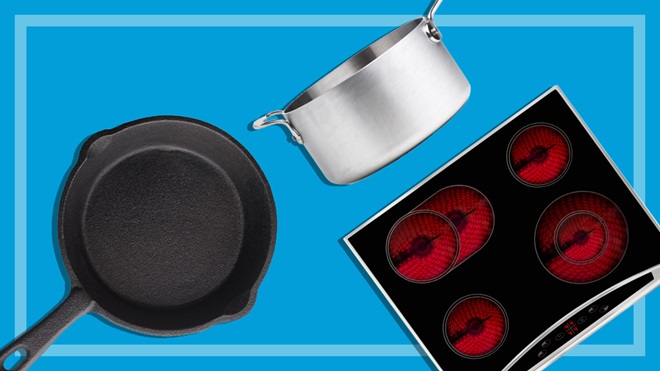Buying an induction cooktop is a big decision. Considering the high price tag, you want to know you're making the right choice, and the same is true for the cookware that goes with it.
Rather than generating heat, induction cooktops produce a magnetic field just above their glass surface. The right induction cookware conducts heat evenly and efficiently, but some base materials achieve this better than others.
On this page:
- Is your cookware induction-compatible?
- Which cookware material is best?
- The best pans for slow and fast cooking
- How much does induction cookware cost?
Is your cookware induction-compatible?
To check whether your existing pots and pans will work on an induction cooktop, you'll need to see if they have a ferrous base by placing a magnet on them. If the magnet sticks well, you're good to go. If not, you'll have to invest in some new cookware.
Which cookware material is best?
Cast iron, steel, some enamelled steel, and stainless steel pans with an iron base or core are suitable, but glass, aluminium and copper generally are not. If in doubt, look for the induction-compatible symbol or try the magnet test.
Stainless steel
Stainless steel is a popular choice for cookware because it's strong, hard and non-corrosive. It's not the best conductor of heat, so it's often combined with aluminium in multi-layered bases.
Cast iron
Cast iron cookware can be pricey, but it's very durable if looked after properly. It gives very even heat transfer at low settings, but because of its thick and heavy base, it takes longer to heat up and cool down than other types of cookware. Some cast iron pans have an enamelled cast iron base that helps prevent rust, but if handled roughly this type of cookware can chip and become brittle.
Aluminium
Aluminium conducts and retains heat very well, is lightweight, affordable and doesn't rust – but aluminium alone is incompatible with induction. Manufacturers overcome this by using a stainless steel plate on the base of an aluminium pan to make it compatible for induction. The plate generates the heat from the induction cooktop and passes it through to the rest of the pan.
The best pans for slow and fast cooking
For slow and steady cooking, use heavy-based pans. These will react more slowly to the cooking zone and generally take longer to heat up, but they'll give you even and consistent heating. They're versatile and ideal for cooking delicate foods and meals that require a long cooking time. These bases tend to be thicker and made of aluminium (with a steel cap in the base) or cast iron.
For fast cooking, stainless steel-layered bases are best – they heat up quickly and react quickly to changes in the temperature setting. These pans tend to have a thinner base, and if you don't keep an eye on things they could be more prone to burning, overcooking and sticking (unless it's a non-stick pan). These pans are ideal for boiling water and steaming.
How much does induction cookware cost?
Induction cookware tends to range from $50 up to $300. Each pan will respond differently to your cooktop, so before you invest in a whole set of saucepans and frypans from the same brand, choose a single pot or pan first – something basic like a good all-purpose saucepan – and see how it performs.
Good-quality cookware may cost a bit more, but it's likely to outlast cheaper varieties, which will save you money in the long run.
Stock images: Getty, unless otherwise stated.




